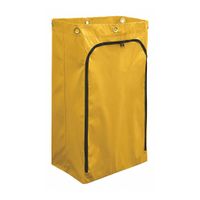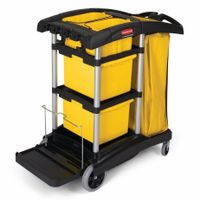Call +(254) 703 030 000 / 751 483 999 / 721 704 777
- Home
- Cleaning And Janitorial
- Cleaning Supplies
- Cleaning Carts
.....Read More
Frequently Asked Questions
What are the essential items to include in a cleaning cart?
A well-stocked cleaning cart is essential for efficient and effective cleaning. Key items to include are:
1. **Cleaning Solutions**: Multipurpose cleaner, glass cleaner, disinfectant, and floor cleaner to tackle various surfaces and areas.
2. **Tools and Equipment**:
- **Mop and Bucket**: For floor cleaning.
- **Broom and Dustpan**: For sweeping debris.
- **Duster**: For dusting surfaces and hard-to-reach areas.
- **Scrub Brushes**: For scrubbing tough stains.
- **Squeegee**: For cleaning windows and glass surfaces.
3. **Cloths and Sponges**: Microfiber cloths for dusting and wiping, and sponges for scrubbing.
4. **Gloves and Protective Gear**: To ensure safety while handling chemicals.
5. **Trash Bags**: For collecting waste and replacing liners in trash bins.
6. **Paper Towels and Rags**: For drying and wiping surfaces.
7. **Spray Bottles**: For easy application of cleaning solutions.
8. **Toilet Brush and Cleaner**: Specifically for bathroom cleaning.
9. **Air Freshener**: To maintain a pleasant scent in cleaned areas.
10. **Signage**: "Wet Floor" signs to ensure safety during and after cleaning.
11. **Storage Compartments**: For organizing and accessing items easily.
12. **Personal Protective Equipment (PPE)**: Masks and goggles if dealing with harsh chemicals.
13. **Hand Sanitizer**: For personal hygiene after cleaning tasks.
14. **Checklist or Schedule**: To ensure all tasks are completed efficiently.
These items ensure that cleaning staff can perform their duties effectively, maintaining hygiene and safety standards.
How do you organize a janitorial cart for efficiency?
To organize a janitorial cart efficiently, start by categorizing items based on their use and frequency. Place frequently used items like spray bottles, microfiber cloths, and disinfectants on the top shelf for easy access. Arrange them in a way that allows quick retrieval, such as grouping similar items together.
On the middle shelf, store cleaning supplies that are used regularly but not as frequently as those on the top shelf. This can include items like dusters, sponges, and additional cleaning solutions. Ensure these items are neatly organized to prevent clutter and make them easy to find.
The bottom shelf should hold bulkier items or those used less often, such as mop heads, extra trash bags, and larger cleaning tools. This keeps the cart balanced and prevents it from tipping over.
Attach a trash bag holder to the side of the cart for easy disposal of waste. Keep a small supply of trash bags within reach to replace them quickly. Utilize hooks or holders on the sides of the cart for brooms, mops, and dustpans, ensuring they are secure and do not fall off during movement.
Incorporate a caddy or small container for personal protective equipment (PPE) like gloves and masks, ensuring they are readily available. Label shelves or sections if necessary to maintain organization and assist others in finding items quickly.
Regularly check and restock the cart to ensure all necessary supplies are available. Keep the cart clean and tidy to maintain a professional appearance and enhance efficiency. By organizing the cart in this manner, you streamline the cleaning process, reduce time spent searching for items, and improve overall productivity.
What are the best cleaning cart accessories to improve functionality?
The best cleaning cart accessories to improve functionality include:
1. **Trash Bag Holders**: These allow for easy disposal of waste, keeping the cart organized and reducing the need for frequent trips to the trash bin.
2. **Adjustable Shelves**: Customizable shelves provide flexibility to store various cleaning supplies, ensuring that everything is within reach and organized.
3. **Tool Holders and Hooks**: These are essential for hanging brooms, mops, and dusters, preventing clutter and making it easy to access tools quickly.
4. **Lockable Compartments**: Secure storage for chemicals and valuable items, ensuring safety and compliance with regulations.
5. **Utility Buckets**: Removable buckets for carrying water or cleaning solutions, making it easier to transport liquids without spills.
6. **Caddies and Trays**: Portable caddies for smaller items like spray bottles, cloths, and brushes, allowing for easy transport and organization.
7. **Bumper Guards**: Protect walls and furniture from damage as the cart is moved around, extending the life of both the cart and the surroundings.
8. **Non-Marking Wheels**: Smooth, non-marking wheels ensure easy maneuverability and prevent floor damage, especially on delicate surfaces.
9. **Sign Holders**: Integrated holders for wet floor signs or other safety notices, ensuring compliance with safety protocols.
10. **Charging Stations**: Built-in charging ports for electronic cleaning equipment, ensuring devices are always ready for use.
11. **Ergonomic Handles**: Adjustable and comfortable handles reduce strain on the user, improving efficiency and reducing fatigue.
12. **Label Holders**: Clear labeling of compartments and shelves for easy identification and organization of supplies.
These accessories enhance the efficiency, safety, and organization of cleaning operations, making the cleaning process more effective and less time-consuming.
How do you maintain and clean a housekeeping cart?
To maintain and clean a housekeeping cart, follow these steps:
1. **Daily Inspection**: At the start of each shift, inspect the cart for any damage or wear. Check wheels for smooth movement and ensure handles are secure.
2. **Organize Supplies**: Arrange supplies systematically. Place cleaning agents, cloths, and tools in designated compartments. Keep frequently used items within easy reach.
3. **Stock Inventory**: Replenish supplies such as toiletries, towels, and linens. Ensure an adequate stock of cleaning agents, trash bags, and other essentials.
4. **Clean the Cart**: At the end of each shift, remove all items and wipe down the cart with a disinfectant. Pay attention to handles and frequently touched areas.
5. **Check Equipment**: Ensure all equipment, like vacuum cleaners or mops, is in working order. Clean and maintain them as per manufacturer instructions.
6. **Dispose of Waste**: Empty trash bags and dispose of waste properly. Replace with new bags to prevent odors and contamination.
7. **Restock and Reorganize**: After cleaning, restock the cart with fresh supplies. Organize items neatly to prevent spillage and ensure easy access.
8. **Secure Hazardous Materials**: Store chemicals and cleaning agents securely to prevent leaks and ensure safety. Label them clearly.
9. **Review Safety Protocols**: Regularly review safety protocols for handling chemicals and equipment. Ensure all staff are trained and aware of emergency procedures.
10. **Weekly Deep Clean**: Conduct a thorough cleaning weekly. Disassemble removable parts and clean them separately. Check for any repairs needed.
11. **Documentation**: Keep a log of maintenance and cleaning activities. Note any issues or repairs needed for future reference.
By following these steps, you ensure the housekeeping cart is clean, organized, and ready for efficient use.
What are the benefits of using a cleaning cart in a hotel or office setting?
Using a cleaning cart in a hotel or office setting offers several benefits:
1. **Efficiency**: Cleaning carts allow staff to carry all necessary supplies and tools in one trip, reducing the time spent fetching items and increasing productivity.
2. **Organization**: Carts provide designated spaces for different cleaning products, tools, and waste, ensuring that everything is organized and easily accessible.
3. **Mobility**: Equipped with wheels, cleaning carts are easy to maneuver, allowing staff to move quickly between areas without carrying heavy loads.
4. **Professionalism**: A well-stocked and organized cart presents a professional image to guests and employees, reflecting the establishment's commitment to cleanliness.
5. **Safety**: Carts help in safely storing cleaning chemicals and tools, reducing the risk of spills, accidents, or misuse.
6. **Versatility**: Many carts are customizable with adjustable shelves and compartments, allowing them to be tailored to specific cleaning tasks or environments.
7. **Waste Management**: Integrated waste bins and compartments for recyclables help in efficient waste collection and disposal, promoting environmental responsibility.
8. **Inventory Control**: By keeping all supplies on the cart, staff can easily monitor inventory levels and restock as needed, preventing shortages.
9. **Ergonomics**: Carts reduce the physical strain on staff by minimizing the need to carry heavy supplies, promoting better health and reducing fatigue.
10. **Cost-Effectiveness**: By improving efficiency and reducing the time needed for cleaning tasks, carts can lead to labor cost savings and better resource management.
Overall, cleaning carts enhance the effectiveness and professionalism of cleaning operations in hotels and offices, contributing to a cleaner, safer, and more welcoming environment.
How do you choose the right cleaning cart for your needs?
To choose the right cleaning cart, first assess your specific needs and environment. Consider the size of the area to be cleaned and the type of cleaning tasks required. For large spaces like hotels or hospitals, opt for a larger cart with multiple compartments to hold various cleaning supplies and equipment. For smaller areas, a compact cart may suffice.
Evaluate the materials of the cart. Durable materials like stainless steel or heavy-duty plastic are ideal for frequent use and harsh cleaning chemicals. Ensure the cart has sturdy wheels for easy maneuverability, especially in tight spaces or over different floor types.
Consider the storage capacity. A cart with multiple shelves, hooks, and compartments can help organize cleaning tools, chemicals, and waste. Look for features like a locking cabinet for secure storage of hazardous materials.
Ergonomics and ease of use are crucial. Choose a cart with adjustable handles to accommodate different user heights and reduce strain. Lightweight carts are easier to push, especially when fully loaded.
Assess the cart's adaptability. Some carts offer modular designs, allowing you to add or remove components based on changing needs. This flexibility can be beneficial in dynamic environments.
Budget is also a factor. While it might be tempting to choose a cheaper option, investing in a high-quality cart can save money in the long run by reducing replacement frequency and maintenance costs.
Finally, consider any specific requirements, such as color-coding for different areas or tasks, or carts designed for specific industries like healthcare, which may require additional features like antimicrobial surfaces.
What are the safety tips for using a janitorial cart?
1. **Proper Loading**: Distribute weight evenly to prevent tipping. Place heavier items at the bottom and lighter ones on top.
2. **Secure Supplies**: Use straps or compartments to secure cleaning supplies and prevent spills or falls.
3. **Organize Tools**: Keep tools and supplies organized for easy access and to avoid clutter that can lead to accidents.
4. **Check Wheels**: Regularly inspect wheels for damage and ensure they roll smoothly to prevent accidents.
5. **Use Caution with Chemicals**: Store chemicals in designated compartments, ensuring lids are tightly closed to prevent leaks and fumes.
6. **Avoid Overloading**: Do not exceed the cart’s weight capacity to maintain stability and maneuverability.
7. **Maintain Cleanliness**: Regularly clean the cart to prevent buildup of dirt and grime, which can cause slips or contamination.
8. **Use Proper Lifting Techniques**: When loading or unloading, use proper lifting techniques to avoid strain or injury.
9. **Navigate Carefully**: Move the cart slowly, especially around corners and in crowded areas, to avoid collisions.
10. **Park Safely**: When not in use, park the cart in a designated area out of the way of foot traffic to prevent tripping hazards.
11. **Regular Maintenance**: Perform regular maintenance checks to ensure all parts of the cart are in good working condition.
12. **Training**: Ensure all users are trained in proper cart usage and safety protocols.
13. **Emergency Preparedness**: Equip the cart with a first aid kit and emergency contact information.
14. **Use Signage**: Attach warning signs to the cart when cleaning in progress to alert others of potential hazards.
15. **Personal Protective Equipment (PPE)**: Wear appropriate PPE, such as gloves and goggles, when handling cleaning chemicals.

